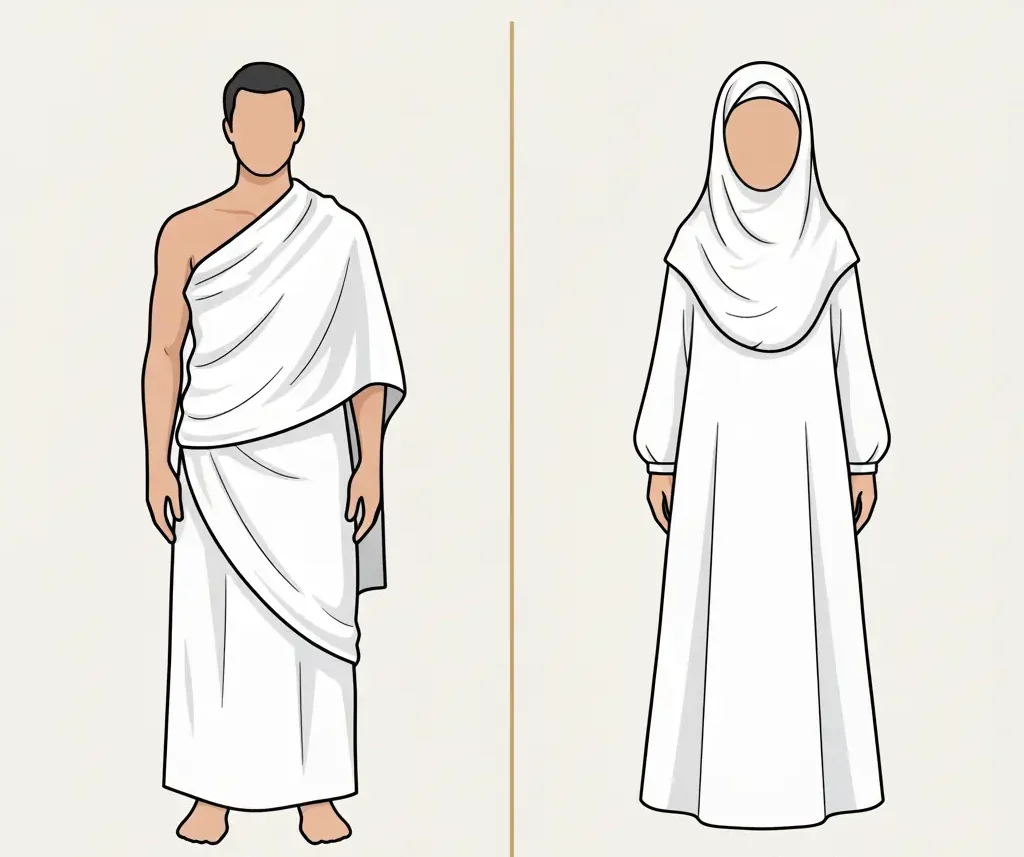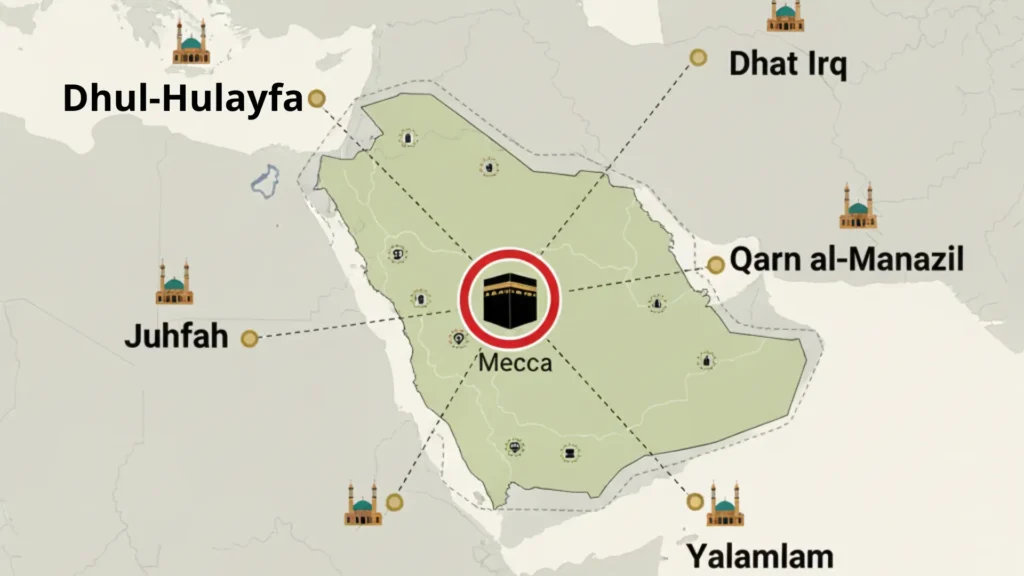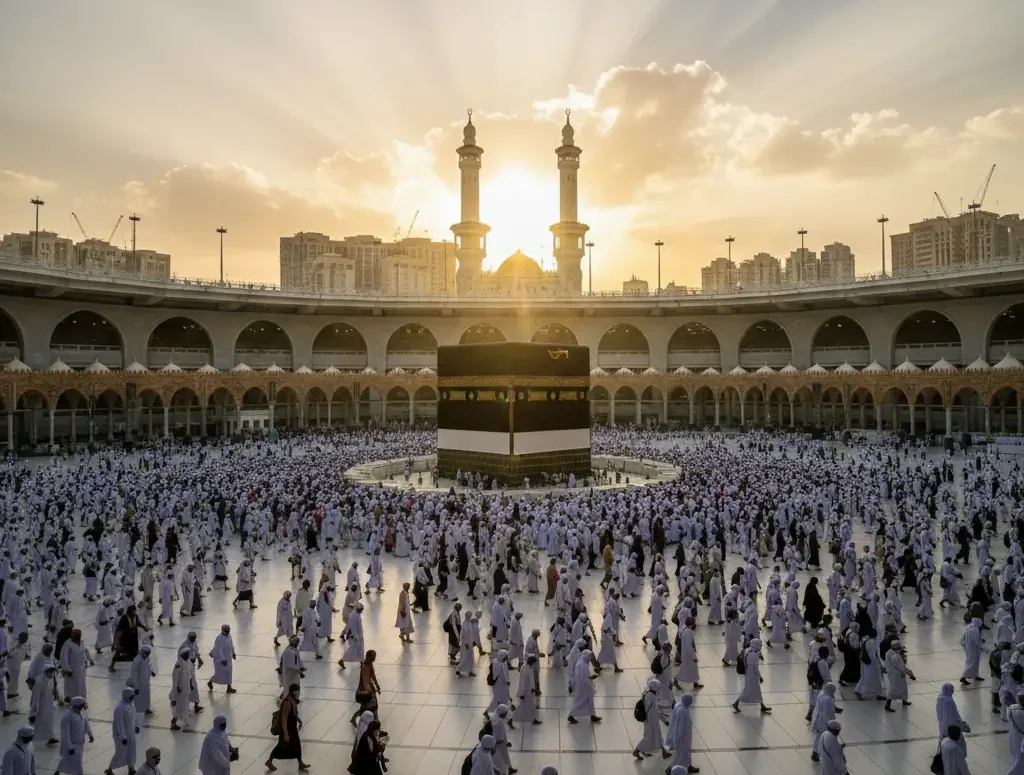Ihram is often misunderstood as merely a set of clothing. In reality, it’s a sacred state of being that pilgrims enter before performing Hajj (the mandatory pilgrimage) or Umrah (the voluntary pilgrimage). This spiritual condition should be assumed before crossing the Miqat boundary. It involves specific garments, intentions, and prohibitions that symbolize purity, equality, and devotion to God.
In this comprehensive guide, we’ll explore everything you need to know about Ihram for 2026—from its deep spiritual significance to practical step-by-step instructions. Let’s embark on this journey together!
Table of Contents
What Exactly is Ihram? Beyond the White Garments
The word “Ihram” originates from the Arabic root “ḥarama”, which means “to be forbidden” or “sacred”1. This etymology reveals the essence of Ihram—it’s a state where certain ordinarily permissible actions become forbidden, creating a sacred space for spiritual devotion. An individual in the state of Ihram is known as a Muhrim, literally meaning “one who has made things forbidden upon himself.” The two-piece garment worn by men is also referred to as the Ihram.

Ihram encompasses three interconnected dimensions:
- Physical: Clothing & Physical Purity — cleansing, wearing the prescribed garments (for men especially), cleanliness.
- Mental: Intention (Niyyah) — deciding in your heart that you’re performing Umrah, Hajj, or both. Sometimes said aloud, but the main thing is the undoubting resolve.
- Spiritual: Prohibited Acts — once in Ihram, there are things you must avoid (we’ll get to those more in a moment).
When you see pilgrims in those simple white garments, you’re witnessing a powerful symbol of human equality. Regardless of wealth, status, or nationality, all pilgrims dress identically, emphasizing that everyone is equal before God . As one source beautifully expresses it: “The Ihram attire removes all semblance of social, cultural and political differences for the sake of equality before God”2 .
The Spiritual Significance of Ihram: Why It Matters
Ihram represents much more than a dress code—it’s a transformative spiritual state that prepares pilgrims for the sacred journey ahead. By shedding their regular clothing and possessions, pilgrims symbolically strip away their ego and worldly attachments, focusing entirely on their relationship with the Divine .
This state of humility and devotion has profound effects on participants. Many describe experiencing a deep sense of peace and connection during their time in Ihram, as the simplified attire and restrictions help minimize distractions from worldly matters .
The renowned Islamic scholar Imam Al-Ghazali compared Ihram to the shroud worn in burial, reminding pilgrims of their ultimate return to God. This perspective highlights how Ihram serves as a powerful memento mori, encouraging reflection on life’s purpose and the afterlife.
Ihram Attire: What Men and Women Wear

Ihram For Men:
Men’s Ihram consists of two simple, unstitched white cloths:
- Izar: The lower garment wrapped around the waist
- Rida: The upper garment draped over the shoulders
The clothing must be plain and unadorned, without any decorations or patterns. Men are not allowed to wear stitched clothing, underwear, or anything that fits the contour of the body . They must leave their heads uncovered and cannot wear shoes that cover the ankles or the top of the foot.
Ihram For Women:
Contrary to popular belief, women have more flexibility in their Ihram attire. They can wear any color of modest, loose-fitting clothing that covers the entire body except for the hands and face . The garments should be simple without any embellishments or decorative elements .
Women must not cover their faces with niqab or wear gloves, though they can use a loose veil that doesn’t touch the face according to narration by Aisha (RA):
“We were with the Prophet (ﷺ), and we were in Ihram. When a rider met us we would lower our garments from the top of our heads, and when he has gone, we would lift them up again.” Sunan Ibn Majah 2935
Unlike men, women may wear stitched clothing and closed shoes .
Table: Ihram Clothing Requirements for Men and Women
| Aspect | Men | Women |
|---|---|---|
| Garment Type | Two unstitched white cloths | Modest, loose-fitting clothing (any color) |
| Head Covering | Not allowed | Required (but face must remain visible) |
| Footwear | Sandals that don’t cover ankles/toes | Any comfortable footwear |
| Stitched Clothing | Prohibited | Permitted |
| Face Covering | N/A | Prohibited (niqab not allowed) |
How to Enter Ihram: A Step-by-Step Guide
Entering Ihram involves both physical and spiritual preparation. Here’s the process:
1. Physical Preparation (Before Changing Clothes)
- Trim nails and remove unwanted body hair
- Perform ghusl (ritual purification bath) or at least make wudu (ablution)
- Apply no scents—use unscented soap and avoid perfumes
As narrated by Abu Huraira (RA):
I heard the Prophet (ﷺ) saying. “Five practices are characteristics of the Fitra: circumcision, shaving the pubic hair, cutting the moustaches short, clipping the nails, and depilating the hair of the armpits.” Sahih al-Bukhari 5891
2. Changing into Ihram Garments
- For men, practice wrapping the two cloths securely beforehand
- For women, choose comfortable, modest clothing that meets the requirements
- Dress in a private area to maintain modesty
3. Pray Two Rak’ahs of Salah
- It’s recommended to pray two units of prayer after changing into Ihram garments
- Recite Surah al-Kafirun in the first rak’ah and Surah al-Ikhlas in the second after Surah Al-Fatiha.
4. Making the Intention (Niyyah)
- Formulate your intention in your heart for either Hajj or Umrah
❁ لَبَّيْكَ اللّهُمَّ عُمْرَةً ❁
Labbayka Llāhumma ʿUmrah.
O Allah, here I am to perform Umrah.
❁ لَبَّيْكَ اللّهُمَّ حَجاً ❁
Labbayka Llāhumma Hajj.
O Allah, here I am to perform Hajj.
- Recite the Talbiyah:
❁ لَبَّيْكَ اَللَّهُمَّ لَبَّيْكَ – لَبَّيْكَ لَا شَرِيكَ لَكَ لَبَّيْكَ – إِنَّ الْحَمْدَ وَالنِّعْمَةَ لَكَ وَالْمُلْكَ – لَا شَرِيكَ لَكَ ❁
Labbayka Llāhumma labbayk, labbayka lā sharīka laka labbayk, inna l-ḥamda wa n-niʿmata, laka wa l-mulk, lā sharīka lak.
Here I am At Your service, O Allah, Here I am. Here I am At Your service, You have no partner, Here I am. Truly all praise, favour and sovereignty is Yours. You have no partner.
Conditional Ihram: A Provision for Peace of Mind
In the journey of faith, Allah’s mercy always provides solutions for our worldly challenges. One beautiful manifestation of this is the concept of Conditional Ihram (الإحرام المعلق). This is a special provision for those who fear an unforeseen obstacle might prevent them from completing their pilgrimage.
The Islamic legal principle is based on the Quranic verse:
“Allah intends for you ease and does not want to make things difficult for you” (Quran 2:185).
Conditional Ihram is a direct application of this divine compassion.
When Should You Consider a Conditional Intention?
This option is not for everyone. It is specifically designed for pilgrims who have a genuine, specific concern that they might be prevented from completing their rites due to:
- A health condition: A person with an unstable illness who fears a sudden relapse.
- A security or travel restriction: Someone concerned about border closures or political instability.
- An external fear: Any legitimate (halal) excuse that is beyond their control.
If you are in good health and anticipate no issues, you simply enter Ihram with the standard intention.
How to Make the Condition
The process is simple. After making your intention (niyyah) for Umrah or Hajj and reciting the Talbiyah, you add the following condition:
❁ فَإِنْ حَبَسَنِي حَابِسٌ فَمَحِلِّي حَيْثُ حَبَسْتَنِي ❁
Fa in habasani habisun famahilli haithu habastani.
Then if I am prevented by any preventer, my place of ending Ihram is where You have prevented me.
This is based on the following narration by Aisha (RA):
Allah’s Messenger (ﷺ) entered upon Dubaa bint Az-Zubair and said to her, “Do you have a desire to perform the Hajj?” She replied, “By Allah, I feel sick.” He said to her, “Intend to perform Hajj and stipulate something by saying, ‘O Allah, I will finish my Ihram at any place where You stop me (i.e. I am unable to go further).” She was the wife of Al-Miqdad bin Al-Aswad. Sahih al-Bukhari 5089
You are essentially telling Allah: “I am beginning this sacred journey with full sincerity, but if something You deem outside my control stops me, I will end my Ihram at that point.”
What Happens If You Are Prevented?
If you make this condition and are subsequently unable to complete your pilgrimage—for example, if you fall seriously ill and cannot perform Tawaf—you are permitted to:
- Leave the state of Ihram without completing the rituals.
- You incur no penalty (like a sacrifice or fasting) for doing so.
- You are not considered to have broken a vow.
This provision removes a significant burden of anxiety, allowing you to embark on your spiritual journey with a heart at ease, trusting in Allah’s plan and His mercy. It’s a powerful reminder that Islam is a religion of practical wisdom, understanding human circumstances while guiding us toward spiritual fulfillment.
When and Where to Enter Ihram: Understanding Miqat

You must enter the state of Ihram before crossing the Miqat—designated boundary points that mark the beginning of the sacred territory, if failled to do so, a penalty will be due in atonement, although the Hajj or Umrah will remain valid. There are five main Miqat stations:
- Dhul Hulayfah (Abyar Ali): For those coming from the direction of Madinah
- Al-Juhfah (Rabigh): For pilgrims coming from Syria
- Qarn al-Manazil: For those approaching from the east
- Yalamlam: For those coming from Yemen
- Dhat Irq: For people coming from Iraq
If you’re traveling by air, airline staff will typically announce when you’re approaching the Miqat, giving you time to prepare . Many pilgrims choose to wear their Ihram garments before boarding or during a stopover to avoid last-minute rushing .
Prohibitions During Ihram: What to Avoid

While in the state of Ihram, certain normally permissible actions become forbidden. These restrictions are designed to cultivate mindfulness and spiritual focus:
- No cutting hair or nails
- No use of perfumes or scented products
- No sexual activity or flirtatious behavior
- No hunting or killing animals
- No arguing or using foul language
For men, additional restrictions include:
- No wearing stitched clothing
- No covering the head
For women, additional restrictions include:
- No covering the face (with niqab)
- No wearing gloves
If any of these prohibitions are violated, wither unintentionally or not, pilgrims may need to offer expiation (kaffarah), which could involve fasting, feeding the poor, or sacrificing an animal, depending on the violation.
Comparing Ihram in Hajj vs Umrah
While both pilgrimages share much, there are a few important differences when it comes to how Ihram plays out in each. Understanding them helps avoid confusion.
| Aspect | Ihram in Umrah | Ihram in Hajj |
|---|---|---|
| Timing / Window | Can be done nearly any time of year. | Must be during the specific period of Hajj: Dhu al-Hijjah. |
| Duration of Prohibitions | Ends when you complete the Umrah (after Saʿi, Tawaf, and then shaving/cutting hair). Islamic Relief | Prohibitions remain over a longer sequence of rituals (Arafah, Muzdalifah, Mina etc.). You remain in Ihram for much longer. |
| Intention (Niyyah) | “Here I am for Umrah” (or equivalent) when entering. | Intention “Here I am for Hajj” (or Hajj & Umrah if doing a combined pilgrimage). |
| Exit from Ihram | After completing the rites of Umrah + ritual cutting/shaving of hair. | Exit only after finishing all Hajj rites, including the sacrifice (if applicable), shaving/cutting hair etc. |
Special Considerations: Menstruation, Illness, and Children
Women in Menstruation
Contrary to common misconception, women can enter Ihram while menstruating. They can perform all rites of Hajj or Umrah except Tawaf (circumambulation around the Kaaba), which they must complete after becoming pure . As narrated by Abdullah ibn Abbas (RA):
The Prophet (ﷺ) said: A menstruating woman and the one who delivered a child should take a bath, put on ihram and perform all the rites of hajj except circumambulation of the House (Ka’bah) when they came to the place of wearing ihram. Sunan Abi Dawud 1744
Health Considerations
Those with health conditions should consult scholars about necessary accommodations. For example, people who need to cover their heads for medical reasons may be permitted to do so, though generally, men should avoid head coverings .
Children in Ihram
There’s no specific requirement for children, but they often imitate their parents’ attire. Boys may wear the two white cloths like their fathers, while girls wear modest clothing like their mothers. This helps children feel included in the spiritual journey .
Common Mistakes to Avoid During Ihram
- Crossing Miqat without intention: Always ensure you’ve made your niyyah and recited Talbiyah before crossing the boundary
- Using scented products: Even unscented deodorant or soap with fragrance can break your Ihram state
- Covering head (for men): Be mindful during sleep or in air-conditioned spaces where you might instinctively cover your head
- Focusing only on outward form: Remember that Ihram is primarily about internal spiritual state, not just clothing
- Neglecting Talbiyah: Recite the Talbiyah frequently throughout your journey to maintain spiritual focus
The Transformative Power of Ihram: Personal Reflections
Beyond the rules and regulations, Ihram offers a profound spiritual experience that many pilgrims describe as life-changing. The simplicity of the attire, the equality among believers, and the detachment from worldly concerns create an environment conducive to deep reflection and connection with God.
As one source beautifully expresses:
“Ihram equalizes us. Whether you’re a CEO or a student, everyone looks the same. There are no brands, no uniforms, no distractions—just hearts exposed before Allah” .
This transformative aspect is perhaps Ihram’s greatest gift. It allows pilgrims to shed their social identities and come before God as equals, focusing on what truly matters: their faith, their shortcomings, and their desire for forgiveness and guidance.
Practical Tips for 2026 Pilgrims
- Practice beforehand: If you’re a man, practice wearing the two Ihram cloths at home to ensure you can secure them properly
- Choose quality fabric: Select breathable, comfortable fabric that won’t become see-through when wet with sweat
- Use an Ihram belt: Consider using a special Ihram belt to secure your clothing and carry essentials securely
- Pack unscented toiletries: Bring fragrance-free soap, shampoo, deodorant, and wet wipes
- Stay hydrated: The simple clothing offers little protection from the sun, so drink plenty of water
Conclusion: Embracing the Journey
Ihram is far more than a pilgrimage uniform—it’s a sacred state of mind and being that prepares us for one of life’s most profound spiritual journeys. By understanding its significance, requirements, and prohibitions, we can fully embrace this transformative experience.
As you prepare for your pilgrimage in 2026, remember that Ihram represents both a beginning and an end: the beginning of your sacred journey and the end of worldly distinctions and attachments. It’s an invitation to stand equal before God, focused solely on your relationship with the Divine.
May your journey be accepted, your prayers answered, and your heart transformed through this incredible experience. Labbayk Allahumma labbayk—Here we are, O Allah, here we are.



